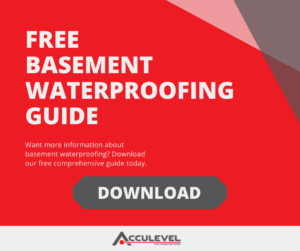What is the Best Water Drainage for Your Basement?
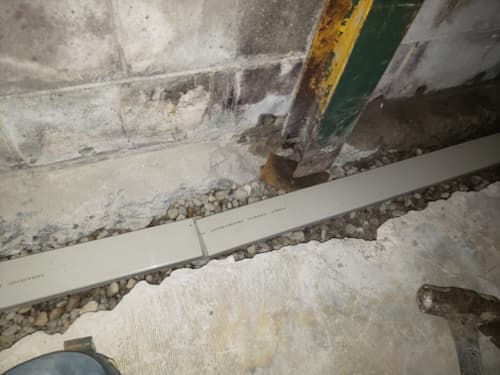
Originally posted 10/20/21, updated 12/15/22
If I asked you to visualize “water drainage” for your basement, what would it look like? Do you imagine something round, like a plumbing pipe? That’s what I pictured when I was new to Acculevel. But I learned otherwise when I asked a coworker to bring me samples of our basement water drainage; all of the samples were rectangular in shape. Once I learned how -and where- water drainage is installed, this made perfect sense. Hopefully, it will to you, too!
Acculevel is a family-owned and operated company that specializes in basement waterproofing and foundation repair. Since we opened our doors in 1996, we’ve helped more than 35,000 homeowners in Indiana (and the surrounding areas) restore their homes to full strength and stability.
Your foundation is a critical part of your home; it literally holds up your house and everything in it. Water is often the enemy of a healthy foundation. Installing water drainage in your basement doesn’t just give you a clean dry basement, although that IS important! Water drainage also reduces the wear & tear of water on your foundation.
In this article, we’re going to discuss our two water drainage solutions for basements, and which one is best for your home.
How Is a Basement Constructed?
When your home was built, the construction team excavated a large hole on the property. It wasn’t the exact size of your basement; it was several feet wider and deeper. This gave the building crew sufficient room to maneuver around the basement as they constructed it.
What Are Footers?
Once the excavation was completed, the footers were poured. Footers are large concrete slabs, sometimes with iron rebar inside, that are put in place around the perimeter of a home. They’re somewhere between 16-24 inches wide, and they’re essential for stabilizing your home.

This illustration was created by the author, who is not a graphic designer.
Why Are Footers Important?
Without a footer, the weight of your home would be resting on the narrow walls of your basement. The average concrete block is only 8 inches wide, so it wouldn’t be an adequate weight distribution. Imagine how heavy your home is, and narrow an 8 inch block is. It might seem like you’re asking an elephant to balance on a stiletto heel!
The footer below the foundation is substantially wider, however. This added size makes it a stronger and more supportive base, because the weight of your home is more evenly distributed across a larger surface. Once all the footers are cured (set up), the basement walls are built on top of them. The basement floor is poured after the walls are built.
After The Basement Is Built, Drainage is Installed
At this point, the construction team installed exterior drainage around the outside of the basement. Now this is the pipe-style drainage that many of us picture as “typical water drainage.” It’s a corrugated plastic, vinyl or perforated pvc pipe, surrounded by gravel. A water-resistant “mastic” (coating) is also usually applied to the outside of the foundation. Once this is complete, the gap around the basement is filled. The material used is mostly soil (backfill from the original excavation) mixed with some type of gravel or stone.
If Your Home Has Exterior Water Drainage, Why Is Water Getting into Your Basement?
I can almost hear you protesting, ”if there’s water drainage outside my basement, why is there water in my basement?”
This is a good question, and I don’t blame you for asking. Simply put? Exterior water drainage is not designed to be permanent. It usually works for 15-25 years, depending on your home, soil properties, and rainfall. Over time, the drainage pipe will clog and fill with dirt, sand, and debris.
Additionally, having a functional exterior drainage doesn’t prevent water intrusion entirely. If your soil is saturated for long periods of time, it’s going to start pushing against your foundation. This creates hydrostatic pressure, which is a major cause of foundation cracks, water intrusion, and bowing or shearing basement walls. Once enough pressure forms, water starts seeping into your basement.
What’s the Point of Exterior Water Drainage, Then?
It keeps the water out of your basement for a long period of time, including when the home is new and covered by warranty. I’m sorry if this sounds unduly cynical, but after researching the limits of home warranties, I believe it’s accurate.
The only way to repair these exterior drains is to excavate the perimeter of your house, dig up the old buried perforated pipe, and replace it. Like other waterproofing companies, Acculevel can install exterior water drainage. But we prefer to install interior waterproofing.
Why Do We Discourage Re-Installing Exterior Water Drainage?
- Exterior waterproofing is expensive.
- It takes a significant length of time to excavate the ground all around your house. This process disrupts your home and daily routine, makes a terrible mess, and at the end of this hassle? You have drainage that is not going to be a permanent solution.
- Exterior waterproofing doesn’t come with a warranty, because we know it will eventually fail.
Interior Water Drainage is the Best Method for Your Basement
Our interior waterproofing systems are much better for you and your home. Interior drainage costs less than half of the price of exterior drainage. Installation is usually done in a week or less, and doesn’t disrupt your property.
You will have to move your belongings away from the walls of the basement, so the crews have room to work. And you should probably cover furniture and hard-to-dust items with sheets because there will be dust created. But this is far less intrusive and disruptive than excavation. And most important of all? We provide a warranty that it will not clog for the life of your structure.
Acculevel Offers Two Kinds of Interior Basement Water Drainage
We have two different options, when it comes to basement waterproofing: water tunnel and fast track. But you don’t choose which one you want; your footer does. This may sound odd (who am I kidding? It sounds absurd!), but it’s accurate.
Water Tunnel is Less Expensive
Water tunnel is a drainage system that only has three sides. The fourth side, the bottom, is left open because it will be completed by the footer . Remember how I mentioned that our water drainage was rectangular, instead of round? This is why it has flat sides- so it can “sit” level on the concrete footer.

Photos by the author
To install the water tunnel, the crew breaks up a narrow portion of your basement floor along the perimeter. The tunnel is placed on the footer, and pea gravel is used to hold it in place and help filter dirt out of the water.
If your basement wall is made of concrete block: weep holes are drilled into the bottom row of blocks. This allows water that seeps into the wall to drain out. (Water accumulates inside the hollow core of the blocks.) The weep holes are covered with dimple board, so the water is directed down to the drainage instead of out onto your floor.
The drainage is connected and drains to a sump pump, which is installed in a large sump pump pit. Acculevel always installs a sump pump with a battery back-up; this ensures that your system will keep working even if there is a power outage.
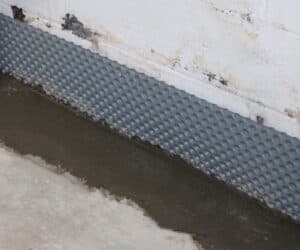
This picture was taken by an Acculevel crew member, after installing water drainage in a customer’s home. Dimple board is attached to the wall, to manage any water that seeps in through the weep holes.
Once the drainage system is installed, the work crew covers it with new concrete, to replace the flooring they removed. Water tunnel costs $67-81 per linear foot.
Fast Track is Necessary in Certain Situations
Whenever possible, we install water tunnel drainage in basements. But if the crew opens up your floor and discovers either your footer or your floor has problems? You’ll need fast track instead.
Unfortunately, we can’t be certain what drainage you’ll need until we open your floor. There are several reasons why water tunnel may not be the best option for your home:
- Your footer is deteriorating or uneven; the water tunnel won’t be level, interfering with water flow and track connections.
- Your footer is narrower than usual; the water tunnel won’t fit onto it securely.
- The basement floor is too thin (less than 4 Inches thick). The water tunnel would make your floor uneven or sloped when we replace the concrete.
- While these conditions can happen anywhere, we see them most frequently with homes that are 75+ years old.
Because the preferred placement on the footer will not work, fast track is designed to go next to the footer in a narrow trench.
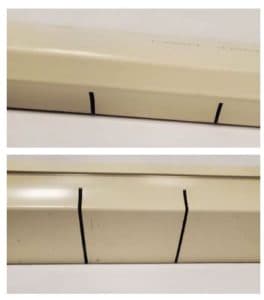
Photos by the author
Fast track is still rectangular, but it has four sides because the bottom can’t rely on the footer to provide the base. There are narrow slits cut into the bottom, to allow water to seep up and into the drainage.
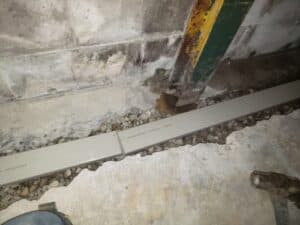
This photo was taken by an Acculevel crew member during fast track installation. You can see the poured concrete footer is uneven and the floor is thin.
Other aspects of the water drainage installation are the same, however. Pea gravel is placed around the track, and the drainage is connected to the sump pump pit. New concrete is then poured over the fast track and the exposed footer, replacing the concrete floor that we removed.
Fast track costs $76-92 per linear foot.
If your water intrusion is very frequent, or if it involves a high volume of water, we may recommend fast track over water tunnel drainage, regardless of your footer condition. Fast track drains at a higher rate.
Does Your Basement Need Water Drainage Installed?
If you live in our service area, call Acculevel at 866-669-3349. Prefer electronic communication? You can fill out our online form to schedule an in-home consultation with one of our expert project advisors.
Our project advisor will arrive on-time, review your concerns, and discuss your plans for your home (is the basement finished? Do you want it to be?). They will evaluate your home, make recommendations, then help you formulate a plan to meet your goals.
You can also learn more about basement waterproofing, by reviewing our in-depth homeowners guide. This is a free resource available to any homeowner, regardless of where they live. In this guide, we tackle all of the most commonly asked questions- from what causes water intrusion, how installation is done, the importance of downspout extensions, product costs, and why encapsulation is important if you want to finish your basement.
If you don’t live in our service area, but need help finding a good waterproofing contractor, you should begin by asking friends and neighbors for recommendations. You can also check with your HOA, your real estate agent, or an online source like Home Advisor.
Please verify that any contractor you work with is insured and accredited by the Better Business Bureau. Online reviews are helpful and often provide great insight into a company, but they can be forged or fabricated. The BBB sets and maintains its own standards, and the approval process is comprehensive. We don’t want anyone taken advantage of by a disreputable person pretending to be a legitimate contractor.
